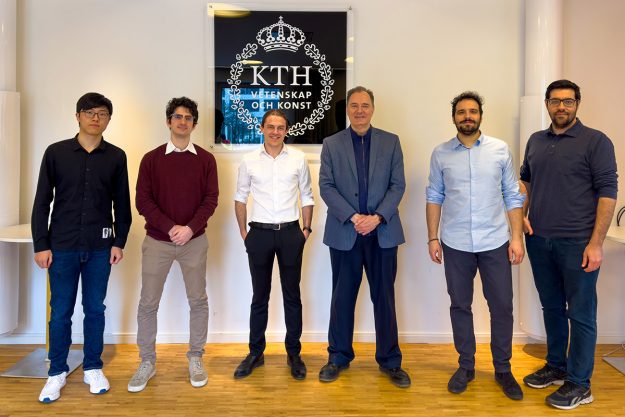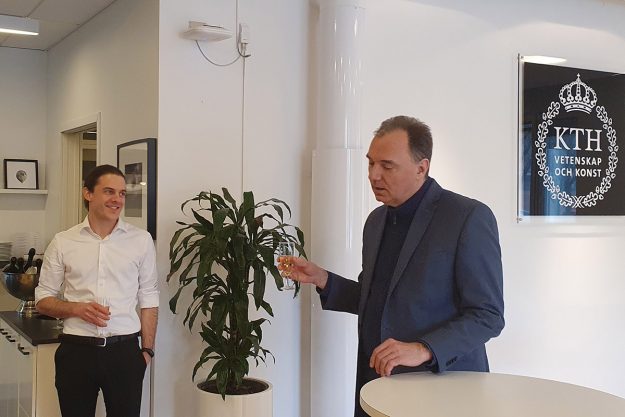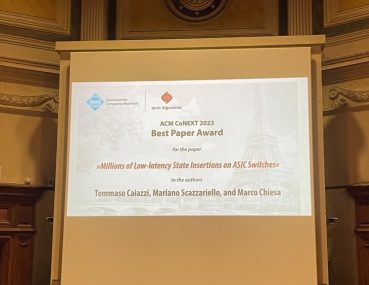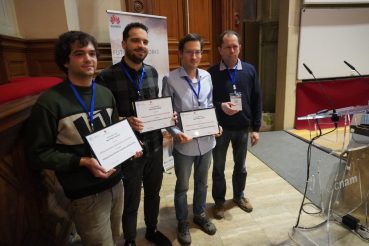Mission
This blog highlights the contributions made by a group of faculty, researchers, and doctoral students working on Networked Systems aspects. For open positions, please consult our Projects.
This blog highlights the contributions made by a group of faculty, researchers, and doctoral students working on Networked Systems aspects. For open positions, please consult our Projects.
We are happy to announce that Giacomo Verardo successfully defended his licentiate thesis (licentiate is a degree at KTH half-way to a PhD)! As usual, Marco Chiesa has done an excellent job as a co-advisor, and we are truly grateful to Prof. Gerald Q. Maguire Jr. for his stellar insights. Dr. Maxime Sermesant was a superb opponent at the licentiate seminar, with Prof. Vlad Vlassov as the examiner. Giacomo ’s thesis is available online:
“Optimizing Neural Network Models for Healthcare and Federated Learning”
Giacomo presenting during the defense (image taken by Massimo Girondi).

Dejan congratulates Giacomo once Prof. Vlassov announced that Giacomo passed his defense (image taken by Massimo Girondi).

Dejan hands the traditional gift to Giacomo (image taken by Voravit Tanyingyong).

Group image with Networked Systems Laboratory members (image taken by Sanna Jarl).
Can Large Language Models facilitate network configuration? In our recently accepted CoNEXT 2024 paper, we investigate the opportunities and challenges in operating network systems using recent LLM models.
We devise a benchmark for evaluating the capabilities of different LLM models on a variety of networking tasks and show different ways of integrating such models within existing systems. Our results show that different models works better in different tasks. Translating high-level human-language requirements into formal specifications (e.g., API function calling) can be done with small models. However, generating code that controls network systems is only doable with larger LLMs, such as GPT4.
This is a first fundamental first step in our SEMLA project looking at ways to integrate LLMs into system development.
GitHub code: link
Hugging Face: link
Paper PDF: link
We are happy to announce that Massimo Girondi successfully defended his licentiate thesis (licentiate is a degree at KTH half-way to a PhD)! Marco Chiesa has done an excellent job as a co-advisor and as is customary we are very grateful to Prof. Gerald Q. Maguire Jr. for his key insights. Giuseppe Siracusano was a superb opponent at the licentiate seminar, with Amir Payberah as the examiner. Massimo’s thesis is available online:
“Toward Highly-efficient GPU-centric Networking”
A few shots from the celebration are below.

Group shot of Networked Systems Laboratory members (Massimo is beneath the KTH logo). Image taken by Voravit Tanyingyong


Dejan hands the gift to Massimo a few weeks later in the hallway that Massimo chose for the shot. Definitely looks better than the opposite side we used in the past! (image taken by Voravit Tanyingyong)
Dejan is deeply honored to become a Wallenberg Scholar! This grant comes with 18 MSEK in funding over five years. More information is available at the KAW website.
We are hugely honored that our “Millions of Low-Latency Insertions on ASIC switches” paper received the Best Paper Award at ACM CoNEXT 2023! More details are available in our earlier post.


From left to right: Tommaso Caiazzi, Mariano Scazzariello, Marco Chiesa, Olivier Bonaventure (TPC co-chair)